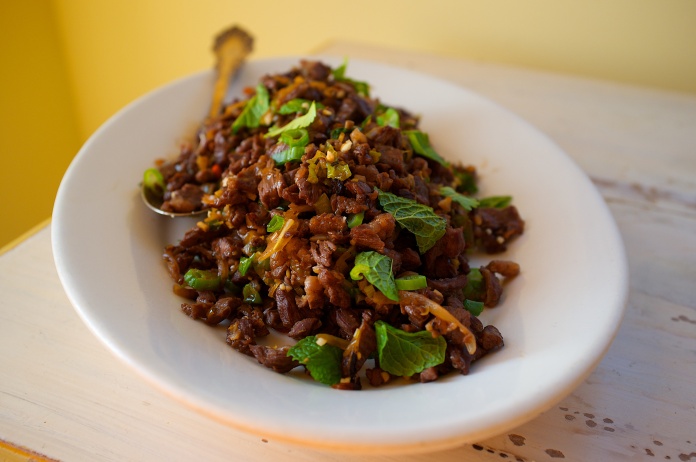Sweetbreads make the perfect po’ boy for anyone not living close to the ocean and oysters, well, and for that matter even those living near the sea may want to give this a go.
It is so amazingly delicous but then you have to be a fan of sweetbreads. If you have never eaten them this would be a good way to go at them for the first time and if you love them you will really like this sandwich. This is also a great latenighter or one of those things you eat when you are the only one at home, then of course, you can revel in its full splendor.
Makes 4 Po’ Boys
To poach the sweet breads:
1 pound, sweet breads, carefully cleaned of any membrane
1 lemon, halved
1 onion, peeled and quarted
2 stalks celery, chopped
2 bay leaves
4 sprigs flat leaf parsley
1 teaspoon whole black peppercorns
11/2 teaspoon kosher salt
4 garlic cloves, crushed
1/4 cup white wine
water
For the poor boy:
blanched sweet breads
2 cups flour, season with 1 teaspoons each black pepper, thyme & paprika
egg wash, two eggs beaten with 1 cup milk
kosher salt
1/2 cup mayonnaise
1 teaspoon lemon juice
1 teaspoon capers, drained and chopped
1/2 teaspoon cornichon pickles, minced
1 teaspoon flat leaf parsley, minced
2 cups romaine lettuce shaved into ribbons
2 loaves french bread, halved
peanut oil for frying
1. Squeeze half the lemon and then drop the spent lemon into a 3 quart pot along with the onion, celery, bay leaves, parsley, peppercorns garlic salt and wine, Add the sweetbreads and enough water to cover.
2. Place the pot over low heat and slowly bring it to a boil, adjusting the heat as necessary. Simmer the sweet breads till just cooked through, not long. Remove them from the heat and let them sit in the poaching liquid until it has cooled.
3. Remove the sweetbreads from the liquid and place them on a parchment lined sheet tray. Place another piece of parchment on top and then a sheet tray. Wrap the whole thing in plastic wrap to keep the sweetbreads from drying out.
4. Put the wrapped contraption into the fridge and place a gallon of milk, or some sort of weight on top of them and let them compress overnight.
5. The next day make the spread. Place the mayo into a small mixing bowl and add the lemon juice from the left over half a lemon, the capers, cornichons, and parsley. Stir the spread and season it with salt and pepper. taste and adjust the seasoning.
6. Remove the sweetbreads from the fridge and unwrap them. Season them with salt.
7. Place 1 inch of peanut oil into a 3 inch high, or higher, Dutch oven and place it over medium high heat.
8. Put the seasoned flour into a paper or plastic bag and add the sweetbreads. Gently roll them around to coat them with the flour. Remove them and drop them into the egg wash. Check the temperature of the peanut oil with a deep fry thermometer. It should be close to 350˚F.
9. If the oil is to temp remove the sweetbreads from the milk, let the excess milk drain back into the pan, and put the sweetbreads back into the flour. Toss them around gently until they are well coated with the flour.
Place them gently into the oil and deep fry them until brown. Remember they are already cooked so you needn’t worry about anything other than making sure they are hot.
10. Once they are browned assemble your sandwiches, bread, spread, lettuce and sweetbreads, then dig in to some good eating.
Note: If you are going to make the fries heat your oven to 250˚F and fry the sweetbreads and then place them on a rack placed over a sheet tray and keep them warm while you fry the fries.

















